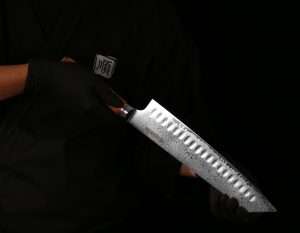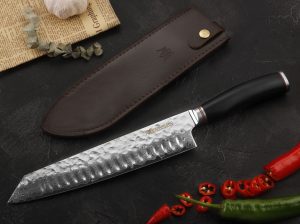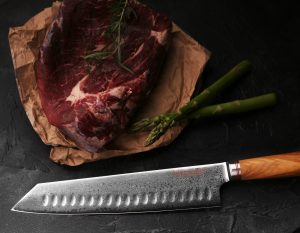1. What Is A Kiritsuke Knife?

The Kiritsuke is one of the few traditionally multi-purpose Japanese-style knives, and is a hybrid between the Yanagiba (raw fish slicer for sashimi) and the Usuba (Japanese-style vegetable knife). This blend makes it a very versatile knife, one of the few Japanese knives that’s actually multipurpose.
There are two types of Kiritsuke knives: the traditional single-beveled Kiritsuke and the modern double-beveled Kiritsuke.
The Kiritsuke is a single-beveled knife, meaning that only one side of the blade is ground to form a razor-sharp edge, and can only be used with the left or right-handed users. It is typically used for slicing sashimi and other raw fish.
A double-beveled Kiritsuke usually refers to a variation of the Gyuto knife with a Kiristuke-style edge. This means they are sharpened on both sides, making them usable for right and left-handed users. YOUSUNLONG’s Kiritsuke knife is a double-edged blade. A knife with a double-edged blade is sharper, also the corresponding sharpness will last longer. And it can be used for a variety of kitchen tasks.
2. What Does Kiritsuke Mean?
Kiritsuke, in Japanese, means to “slit open.” The name is given to the knife due to its extreme sharpness and ability to cut through everything, from vegetables to meat and anything in between. It makes the Kiritsuke an all-rounder for preparing Japanese cuisine.
3. What Is A Kiritsuke Knife Best For?
- Thinly slicing fish, as for sushi or sashimi
- Delicately slicing and chopping vegetables for visually appealing dishes
- Skinning and deboning fish and poultry
- Finely chopping herbs for impeccable garnishes
If you are a cooking lover, you may find the Kiritsuke to be a great ally.
4. What Sets The Kiritsuke Knife Apart?
(1) Kiritsuke vs. Chefs Knife
Comparing the Kiritsuke to a Western chef’s knife, you’ll first notice the massive difference in design. While the chef’s knife features a curved belly on a wider blade, the Kiritsuke has a flat profile.
As a result, a chef’s knife is more beneficial for cutting large pieces of vegetables and offers a higher versatility.
For someone spending a long time in the kitchen, which is required to switch from dicing veggies to deboning meat quickly, a chef’s knife makes for a more sensible option.
On the other hand, Kiritsuke’s angled tip and flat cutting edge allow for incomparable precision cutting. In addition, its design makes it easier to separate thin slices of fish or veggies from each other.
For this reason, it is the best choice for preparing specialty dishes, where the visual aspect is paramount. And so, you can understand why it has become a staple for professional chefs.
(2) Kiritsuke vs. Gyuto
A Gyuto doesn’t differ much from a Western chef’s knife, except for the styling. It features a rounded belly which lends itself well to rock-chopping different foods. Its versatility and ease of use make the Gyuto a better choice for beginners.
In comparison, the Kiritsuke makes for an excellent choice for a push chop or thrust cutting motion, which experienced chefs more commonly use.
(3) Kiritsuke vs. Santoku
You’ll be pressed to find a kitchen enthusiast who hasn’t heard of a Santoku knife before. This type of knife has been popularized by many professional chefs on TV, and it has convinced many users of its utility.
A Santoku is generally smaller and lighter than a traditional chef’s knife, featuring a thinner blade used for precision cutting.
It can slice, dice, and chop various foods, such as fish, meat, and even vegetables.
One of the main differences between a Kiritsuke and a Santoku is their size. A Kiritsuke is usually much longer, while Santokus are great for cooks who want to save space.
While the latter is a preferred choice for many due to its versatility, a Kiritsuke will still win the race regarding accuracy.
5. Recommended Kiritsuke Knives



Kiritsuke Chef’s Knife 10 Inch
- Double-bevel for even more versatility (a double beveled kiritsuke is not the norm, so this is a considerable advantage).
- This knife has a unique & beautiful Tsuchime (“Hammered pattern”) textured Damascus blade.
- Hardness and flexibility are both fantastic features in this Kiritsuke blade.
- Knife surface convex hull with anti-stick effect.
- Handle the natural wood is integrated die casting, will endure heat and wear.
- The handle is also ergonomic for extra control, something that definitely comes in handy while maneuvering with this challenging knife.
The handles are available in three woods: walnut, ebony and olive wood.


